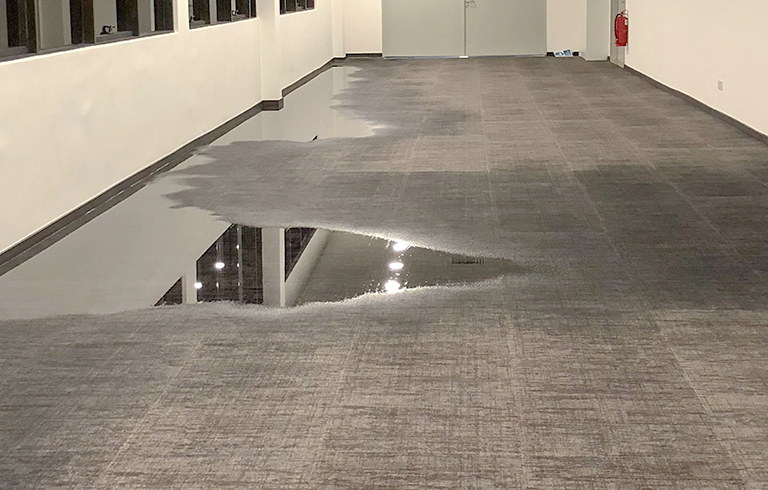Water damage is commonplace in many homes and businesses. Slow drips, burst pipes, roof leaks and the like can introduce large amounts of water into your carpet, if left untreated, this can lead to the growth of mold and mildew. The growth of mold and mildew in the carpet will not only cause it to look unsightly but the spores released by the mold can pose significant health risks to those who are living or working in the area with the damaged carpet.
Most people try to dry out carpet after a flood or leak. However, Improper drying of the carpet can lead to having to replace all the affected carpet in your home or business. There are proper ways of drying the carpet after water damage. These methods can save you money and reduce the amount of time it takes to get back to normal.
What to do before drying?
It is essential to fix the leak that is present before even beginning to remediate the carpet that is damaged. This will ensure that any moisture left behind won’t cause further problems with mold growth and other issues. This may require a plumber or leak expert to fix, they may also be able to suggest ways to spot future leaks faster and how to resolve them.
Once the leak has been fixed, you can then inspect the carpet to see how much of the carpet has been impacted by water. Look for wet spots or any signs of dampness while removing any items that are on sections of wet carpet so that all the areas can be easily reached.
How to dry the carpet?
After removing everything from the area affected by flooding or leaking, begin the drying process immediately. The faster the carpet it dried the lesser the chances of mold and mildew taking hold and rapidly spreading in your carpet.
Remove all excess water that has collected on the carpet
If the carpet is wet such that there is water on the surface, using a wet/dry vacuum to absorb as much of the water out of the carpet as possible. Ensure only a wet/dry vacuum is used as a regular vacuum may be damaged by water ingress. If possible, use attachments that create a strong suction as close to the surface of the carpet as possible to draw out as much moisture as possible.
If such a vacuum is unavailable, or the area that has become wet is small, you may use towels to absorb the water. Lay out towels, spreading them out further than just the wet spot and weigh them down. Using books or other heavy items to apply pressure and draw moisture out of the carpet and into the towels.
Dry the carpet as quickly as possible
Fans and dehumidifiers are your best options to help speed this process up. The lower the humidity in the room the faster the water will evaporate out of the carpet. Using fans will help to speed up the evaporation process.
If you do not have a ceiling fan, make sure you have a desk or stand-alone fan available. You must have some sort of fan to help dry your carpet. Otherwise, it will take a very long time to dry. Make sure the fans are effectively circulating air around the room at high speeds.
If you have small portions of carpet that are wet, you may use a hairdryer on a low setting to gently add some heat from a distance being sure to constantly move the hairdryer to prevent any spots from becoming too hot. Make sure to only check for dryness once it is cool as hot carpet may appear dry even if it is still wet.
Clean and sanitise the carpet
Big Red Carpet Cleaners suggest using professional carpet cleaners to come down to your place and clean the carpets professionally. They will be able to apply anti-microbial coatings to prevent the occurrence of mold. An additional benefit is that professional carpet cleaners will be able to ensure that the carpet underlay has not been affected and also check for any mold growth before they start cleaning. If any of these issues are found they will be able to quickly advise you on the steps to take to restore your carpet to its original condition.
How long should it take for the carpet to dry?
The time taken for the carpet to dry all depends on how wet the carpet was prior to cleaning and how much of the moisture was removed through extraction. The better your extraction the faster the carpet can dry. External factors such as temperature, humidity and wind speed also play a large factor in the drying times of carpets. It is important to take care of water damage immediately. Mold can grow in 48-72 hours after water damage occurs. So, if you do not address the problem within this time frame, the mold will continue to grow and cause additional damage.
If the water in the carpet is unsanitary such as sewage water, do not attempt to remedy the carpet on your own as this can be very dangerous. Everything affected may need to be replaced to prevent pathogenic bacteria from harming those in the space.
If you believe that your carpet has been wet for more than 72 hours and are unsure how to proceed, feel free to contact Big Red Carpet Cleaners for a free consultation to help you decide how to proceed in getting your carpet treated and returned to its original condition. Big Red Carpet Cleaners is a certified member of the Institute of Inspection, Cleaning and Restoration (IICRC) and Carpet and Rug Institute (CRI), which means we continuously update ourselves with the latest scientific and most effective carpet cleaning techniques. We only use the chemicals and cleaning equipment that will provide the best results without causing any damage to your carpet in the process.

